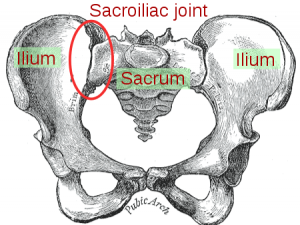Sacroiliac Joints (SIJ)


Sacroiliac Joints (SIJ)
Sacroiliac Joints (SIJ) are critical joints connecting the spine and pelvis, formed between the sacrum and the ilium of the pelvis. It plays a vital role in load transfer, stability, and shock absorption in the human body.
Anatomy
- The Sacroiliac Joint (SIJ) is a large, irregular synovial joint composed of the sacrum and the two innominate bones (each formed by the fusion of the ilium, ischium, and pubis).
- The joint surfaces are irregular and interlock to provide stability. The sacral side is covered with hyaline cartilage, while the iliac side has fibrocartilage.
- The upper one-third of the joint is a syndesmosis (fibrous joint), and the lower two-thirds are synovial, with only the lower third lined by synovium.
- It is surrounded by a strong fibrous joint capsule and reinforced by powerful ligaments:
- Interosseous sacroiliac ligament (strongest, posteriorly located)
- Posterior sacroiliac ligament (covers interosseous ligament)
- Anterior sacroiliac ligament (thinner, anterior side)
- Additional support from sacrotuberous and sacrospinous ligaments.
- The joint is supported by surrounding muscles and fascia, including pelvic floor muscles (levator ani, coccygeus) and large muscles of the lower back and hips.
Function
- The primary function of the SIJ is to transfer and distribute forces between the upper body (axial skeleton) and the lower extremities during standing, walking, and running.
- It acts as a shock absorber for the spine, attenuating forces from the lower limbs.
- The joint converts torque generated by the lower extremities into the rest of the body, facilitating efficient load transfer.
- It provides stability through its irregular surfaces and strong ligamentous support, limiting excessive motion.
- Movements at the SIJ are minimal and include:
- Nutation and counternutation (small tilting movements in the frontal plane)
- Torsion (rotation around an oblique axis in the transverse plane)
- Movement increases during pregnancy due to ligamentous laxity and typically decreases with age as the joint may fuse.
Clinical Relevance
- The SIJ is a common source of lower back and pelvic pain due to inflammation (sacroiliitis), injury, or degenerative changes.
- Its complex anatomy and limited mobility make diagnosis and treatment challenging.
- Understanding its biomechanics is essential for managing conditions like spondyloarthropathies and SIJ dysfunction.
Summary Table
| Aspect | Details |
|---|---|
| Location | Between sacrum and ilium of pelvis |
| Joint Type | Synovial (lower two-thirds), syndesmosis (upper one-third) |
| Cartilage | Sacral side: hyaline cartilage; Iliac side: fibrocartilage |
| Ligaments | Interosseous, posterior, anterior sacroiliac ligaments; sacrotuberous and sacrospinous ligaments |
| Function | Load transfer from spine to lower limbs; shock absorption; stability |
| Movement | Minimal; nutation, counternutation, torsion; increased during pregnancy |
| Support | Strong ligaments and surrounding muscles including pelvic floor muscles |
Consult with Our Team of Experts Now!
At DrStemCellsThailand (DRSCT)‘s Anti-Aging and Regenerative Medicine Center of Thailand, we emphasize comprehensive evaluations and personalized treatment plans of Cellular Therapy and Stem Cells for managing various health conditions. If you have questions about Sacroiliac Joints (SIJ) or would like more information on our services, consult with our experts today!
Consult with Our Team of Experts Now!
References
- Vleeming A, Schuenke MD, Masi AT, et al. The sacroiliac joint: an overview of its anatomy, function and potential clinical implications. J Anat. 2012;221(6):537-567. https://doi.org/10.1111/j.1469-7580.2012.01564.x
- StatPearls: Wong M, Sinkler MA, Kiel J. Anatomy, Abdomen and Pelvis, Sacroiliac Joint. 2020. https://www.ncbi.nlm.nih.gov/books/NBK507801/
- Physio-pedia: Sacroiliac Joint. https://www.physio-pedia.com/Sacroiliac_Joint
- Kenhub: Sacroiliac Joint Anatomy and Function. https://www.kenhub.com/en/library/anatomy/sacroiliac-joint
- Radiopaedia: Sacroiliac Joint. https://radiopaedia.org/articles/sacroiliac-joint
- IJSSurgery: Biomechanics of the Sacroiliac Joint. https://www.ijssurgery.com/content/14/s1/S3
- Spine-Health: Sacroiliac Joint Anatomy. https://www.spine-health.com/conditions/spine-anatomy/sacroiliac-joint-anatomy
- PainTEQ: Exploring SI Joint Anatomy and Its Function. https://www.painteq.com/exploring-si-joint-anatomy-and-its-function
The sacroiliac joint is a vital, highly stable joint that functions as a key load-transferring structure between the spine and lower limbs, combining limited mobility with strong ligamentous support to maintain balance and absorb forces during movement.















